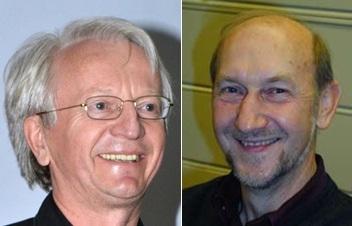Aug 3 2015
An international research group has demonstrated that protein machines, regardless of their specific functions, can collectively induce fluctuating hydrodynamic flows and substantially enhance the diffusive motions of particles in the cell.
 On the left is Prof. Alexander S. Mikhailov, and on the right is Prof. Raymond Kapral. Credit: Fritz Haber Institute of the Max Planck Society and University of Toronto
On the left is Prof. Alexander S. Mikhailov, and on the right is Prof. Raymond Kapral. Credit: Fritz Haber Institute of the Max Planck Society and University of Toronto
Biological cells contain large numbers of active proteins that repeatedly change their conformations. These protein machines have a variety of specific functions, acting as motors, ion pumps, or enzymes, and they need a supply of ATP or other substrates to maintain their cyclic operation.
Professor Alexander S. Mikhailov (Department of Physical Chemistry, Fritz Haber Institute of the Max Planck Society, and Research Center for the Mathematics on Chromatin Live Dynamics [RcMcD] at Hiroshima University) and Professor Raymond Kapral (Department of Chemistry, University of Toronto and Institute for Theoretical Physics, Technical University of Berlin) have suggested that these proteins generate nonthermal hydrodynamic flows, which enhance the diffusive motions of particles. Furthermore, they have theoretically demonstrated a chemotaxis-like drift in the presence of gradients in concentrations of active proteins or substrate (ATP). Such universal nonequilibrium effects hold true for all passive particles and for the protein machines themselves.
As the fluctuating flow fields arise from nonequilibrium effects, work or energy can be extracted from the fields. In other words, these active proteins can supply power to the system in a distributed way, besides performing their specific functions. This may change our views of active processes in the cell.